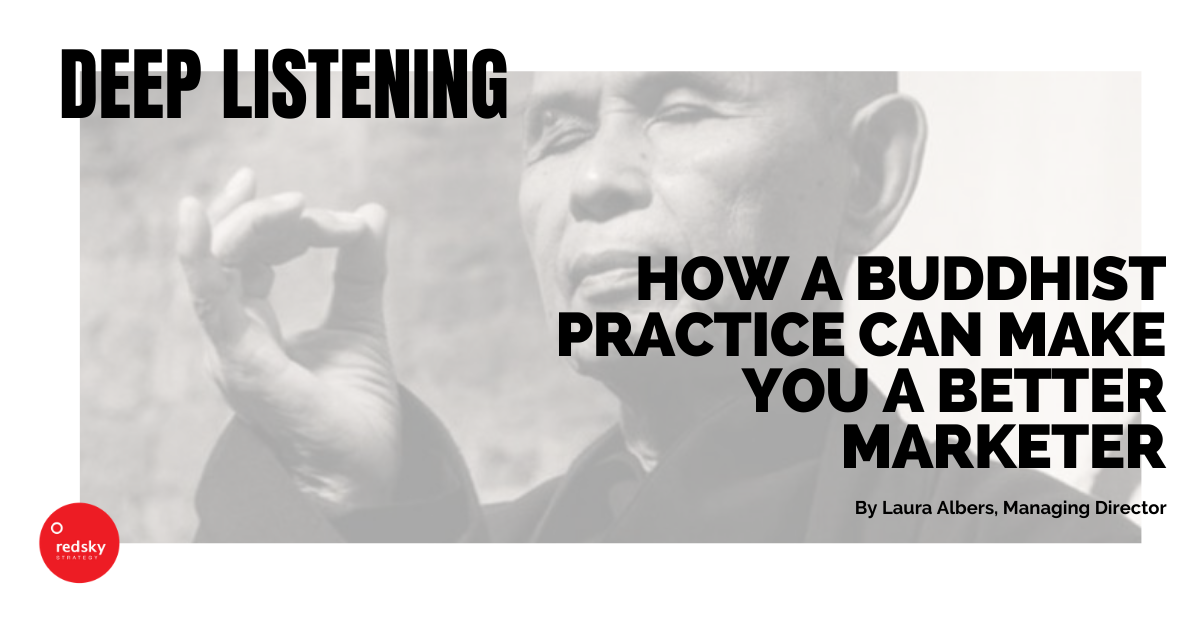News
Deep Listening: How a Buddhist Practice Can Make You a Better Marketer
 By Laura Albers, Managing Director
By Laura Albers, Managing Director
“We have two ears and one mouth so that we can listen twice as much as we speak.”
—Epictetus, Greek philosopher, circa 60 A.D.
Can you remember the last time you were really heard? Take a moment and think about it… when was the last time another person not only listened to the words you spoke but actually understood you? Understood your perspective, both mentally and emotionally? Chances are that happened with another person whom you’re closely bonded with. And chances are those moments aren’t as frequent as you’d like.
To be listened to is a core human need. To be heard is to be understood. Deep Listening is essentially a mindfulness practice. You must listen with your whole self and a quieted mind, giving your full attention, being present and open to another person. It has been defined as “hearing every dimension of the other person, both what is said as well as what is implied. It means to hear the words and the emotions underneath them and to hear the general disposition and mood of the person: to hear all of it.”
I first learned about Deep Listening from the teachings of Thich Nhat Hanh, a Zen Buddhist monk, in his book The Art of Communicating. He also refers to this as compassionate listening. You listen with the intention to help, you listen to let someone empty their heart and help them to suffer less. It benefits both the speaker and listener as the one speaking feels heard, seen, understood, and valued. In turn, the listener also benefits by being able to establish trust, clarify, connect, and empathize.
When applied to marketing and advertising, it begs the question, if we’re unable to provide or receive this with loved ones regularly, how are these brands out in the world really going to “be here for you”? The 2020 insta-classic sentiment that fell flat on its face.
In practice, Deep Listening expands the listeners capacity to bring compassion and empathy to the table. Listening becomes fully sensorial, it can be almost magical or transformative when engaged. The person speaking may find themselves more readily opening up, sharing deeper thoughts, or digging for a truth they themselves may not consciously realize they hold. This is a practice that can improve the quality of your personal relationships greatly and can be tremendously impactful in your professional arenas.
This is why developing the skills of Deep Listening is so appealing. Of the many ways that we can listen to one another, passive listening would be considered the baseline default. This is when we are paying attention but not necessarily present or engaged. We are busy thinking of our own thoughts and responses. We are trained to jump into solutions mode, often interrupting the speaker with tips for rectifying a situation, or describing one’s own similar experience.
Personally, as an extrovert who grew up in a household where the loudest voice is the one that gets heard, and someone who loves banter and lively conversation, not interrupting another is a skill that takes conscious work.
As a qualitative researcher, developing Deep Listening as part of your moderating skill set will set you apart. It is particularly effective for in-depth interviews and focus groups where gaining the trust and confidence of participants is paramount to the quality of the insights gathered. Respondents will feel more comfortable and open up more readily. Clients will be stoked because the conversation is engaging and flowing like they hope it will. You will be happy too because authentic human connection, regardless if for professional or personal reasons, is essential to our well-being, and frankly, feels great.
Here are a few ways you can try it out today, whether it’s on the next Zoom in-depth interview, conference call, focus group or at home with someone in your quar-pod.
1. Set The Intention
-
- Before connecting with others, know that you are showing up to listen first and speak second.
2. Create The Vibe
-
- Creating a safe space and container to share provides comfort and security.
3. Be Present
-
- Bring your whole self. Make eye contact, give focused attention, show an engaged body posture like leaning forward or mirroring the other, and provide acknowledgement with smiles, nods and occasionally repeating their words back to them.
4. Ask Thoughtful Questions
-
- When leading discovery sessions, focus groups, or interviews, it’s your role to encourage people to dig deeper for feelings and perceptions across various categories that they may or may not have passion or deep knowledge on.
5. Hold Your Silence
-
- Allow time for the other person to think and respond. It’s natural to want to fill silence, especially if it’s feeling a bit awkward. But allowing the other to find their words will often result in a surprising answer that can lead to even greater insight, connection and even a transformative experience.
Clear and compassionate communication is challenging to achieve and requires patience to develop. Living in a world of constant notifications of dings, bings, and rings can leave one feeling like there are too many mental tabs open. Responding quickly has become an expectation. Deep Listening is a way to take mindfulness into your work and your life where all can benefit. If this speaks to you, give us a call, we’re all ears.
